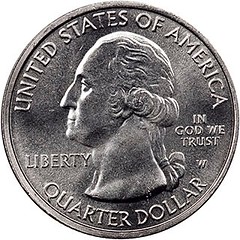
PREV ARTICLE
NEXT ARTICLE
FULL ISSUE
PREV FULL ISSUE
VIC MASON'S THOUGHTS ON U.S. MINT FORUMVic Mason submitted this thoughtful essay inspired by last week's report from the fourth U.S. Mint Numismatic Forum. Thanks! -Editor Many thanks for informing your readers so thoroughly and quickly about the results of the Fourth Numismatic Forum of the United States Mint held late last month in Philadelphia. Patrick Heller's fine summary of the proceedings makes clear that many topics important to the numismatic industry, to dealers and to collectors were covered in the two-day gathering. Mr. Ryder's Plans for Next Year. It's a pleasure to read that Mint Director David Ryder has plans for production of more limited-circulation business strikes in the future, akin to this year's successful program for the five 2019 Washington quarters produced in carefully limited quantities (two million of each national-park design) at the West Point Mint. I expected Mr. Ryder to announce that decision and to continue working with his staff to improve randomness of distribution of the scarce new business- strike coins. At the August 2018 ANA convention in Philadelphia, Mr. Ryder expressed a keen interest in changing the way the Mint did business, in order to appeal to young people to carry on this country's wonderful numismatic traditions. As we all know from personal experience, kids need to be "caught" early, especially during their elementary- and middle-school years, to hope to ingrain in them a love of coin collecting. As Mr. Heller notes, that becomes much more difficult when the hunt for scarce and valuable coins in our pocket change – if not impossible these days – has become much more challenging than it was decades ago.
Direct Collaboration with Schools. So I searched online to find out some basic national statistics about American schools. I found that, between 2015 and 2016, there were roughly 89,000 elementary schools. And in 2001, there were 26,400 public secondary schools and 10,700 private secondary schools, or just over 37,000 high schools. The question I asked myself – as a former classroom teacher and education-program administrator in my long first career – was how best to ensure that, for example, more of this year's 10 million "W" quarters might have ended up in the pockets of excited and appreciative kids. I also thought about what the role of teachers and parent-teacher associations (PTAs) might be in working directly with the United States Department of the Treasury, with the Mint, with their local political representatives (at all levels), and with the banks near their schools, in making "Santa Claus-style" executive decisions. I believe coin-collecting parents among the kids would be happy to help get involved in making sure that the implementation of the local distribution processes in most school districts would be carried out as effectively and transparently as possible. 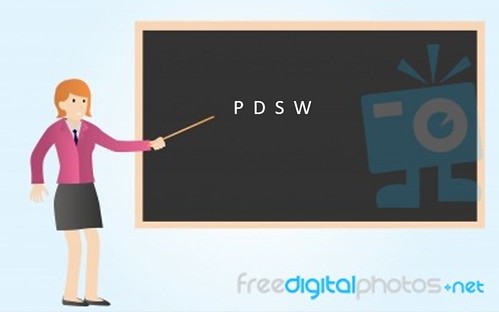 Determination of the Market Values of the "W" Quarters. The good thing about the experience this year with the "W" quarters is that the Mint, the industry and the entire field of coin collecting have gotten a very good idea already of how much the new "W" quarters are "worth" on the market and about how affordable they have become. I just did a survey of several pages of eBay ads for raw and certified "W" quarters – for all five designs – and I'm pleased to say that there are quite a few pieces of the first four releases, which have been certified by Professional Coin Grading Service (PCGS) and Numismatic Guaranty Corporation (NGC), that are being offered for less than $10 each (combining offered price and shipping fees). That includes even certified coins graded as high as MS67. Of course, a lot of coins, both raw and certified, are still priced much more expensively, but those prices have to come under considerable pressure, since there will be no market for them. So the letters of complaint to Coin World should soon stop. I saw no certified Frank Church Wilderness "W" quarters offered for sale yet, but their prices are likely soon to compare with those for the other four issues, if the process of mixing and distribution is the same as for the first four "W" quarters issued this year. The few uncertified examples offered are all advertised as being among those found before the official release date and were so publicized by Coin World in recent weeks. Since so many of the "W" quarters are being pulled out of circulation so soon in mint state condition, even very-high-grade 2019 quarters are now readily affordable. And given the unavoidable contact marks incurred during mixing, bagging and distribution, it will be virtually impossible for anyone except insiders to get their hands on MS-70 examples. However, there is always the possibility that the Mint may decide, unexpectedly, to make the new Frank Church Wilderness "W" quarters much more difficult to find in circulation than has been the case with the first four 2019 "W" designs. It could do that by mixing the Frank Church "W" coins not only among the Frank Church P and D quarters – the practice followed with each of the first four 2019 "W" quarter designs – but, in a very laborious and, no doubt, time-consuming extra step, by mixing them among the entire population of circulated 2019 and pre-2019 quarters. That would make the search for the Idaho quarters much tougher – and thus make the mint-state Idaho "W" quarters much more valuable. Mr. Ryder has not tipped his hand as to what he plans to do with these last 2019 quarters or with the new coins next year. Mr. Heller says only that Mr. Ryder "may revise the process in how [the 2020 coins] are dispersed." New Kennedy Quarters and Innovation Dollars. Mr. Heller suggested the Mint follow a similar distribution plan for the new Kennedy half dollars and one-dollar Innovation coins. He proposes a demand-side approach to increasing interest in these two series. How about a supply-side tack instead, similar to the year-2000 program organized with the Kellogg Company to put Sacagawea dollars randomly into cereal boxes. But the initiative could be conducted on a much broader scale in cooperation with many more manufacturers than the 5000 Sacagawea dollars distributed by Kellogg in 2000. Why not have a public- private partnership (PPP) to implement such a program with as many companies collaborating as possible? The Mint could follow both approaches simultaneously, thereby seeing experimentally which works better and/or is more popular with the public. Or both approaches (including both proofs and circulating issues) could be pursued. 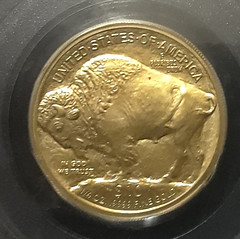 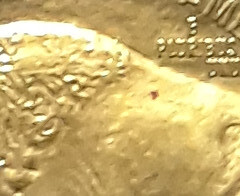
Copper spot on a gold Buffalo Copper Spots on Gold Coins. It was good to learn about the chemical causes of the copper spots on gold coins. A decade ago, I received an MS-68 grade from PCGS on a 2008-W burnished quarter-ounce Gold Buffalo, while the tenth-ounce, half-ounce and one-ounce coins in that valuable set all came back with higher grades, two of them as MS-70. The quarter-ounce coin had an unsightly copper spot on it. Perhaps one of E-Sylum's experts could explain whether that single blemish – other things being equal – would be enough to knock down the grade and the market value of the coin so significantly. I also have such a glaring spot on a 1909-S Indian Head cent graded MS 63, red-brown, by PCGS. Impurities Refined Out of Gold and Platinum Coins. The article says that U.S. Mint Chief Assayer Jeannette Grogan mentioned that there are up to 13 potential impurities in gold that the Mint tests for, and 24 in platinum. Perhaps the Mint secretly could deliberately retain microscopic quantities of a certain chemical, or chemicals, in the alloy mix, for an entire production run of an issue, for either a bullion or a commemorative coin. Then no matter how perfectly – with state-of-the-art technology – a counterfeit might be made (of, for example, an otherwise very rare or scarce issue), the Mint would always be able to prove definitively whether or not a coin was an official government product. Embargoed Early Distribution of New Coins. I think it's a bad idea for the Mint to seriously consider shipping any coins early to purchasers. We saw a few years ago how there are always insiders ready to game the system for selfish profit. I'm thinking back to the attempts by some insiders, in late 2014, to obtain early releases of a few of the 2015 U.S. Marshals Service Commemorative coins celebrating the 225th anniversary of that agency. When those efforts were revealed, the insiders were forced to return the coins to the Mint. Dates and Mint Marks on the Edges of Coins. I hope that no dates and mint marks on US coins are ever again approved for placement on their edges. Even if I had the eyesight of 70 years ago, I would still say that anyone promoting such an absurd placement of important data on coin edges is thinking like a bureaucrat, not a collector. I'm sure Teddy Roosevelt 110 years ago would have snorted derisively at such a design move – as if the main two faces of a coin didn't have enough "space" for those five little symbols: the date and the mint mark. To read the earlier E-Sylum article, see:
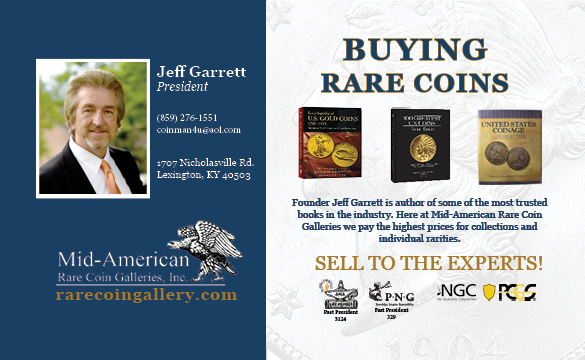 Wayne Homren, Editor The Numismatic Bibliomania Society is a non-profit organization promoting numismatic literature. See our web site at coinbooks.org. To submit items for publication in The E-Sylum, write to the Editor at this address: whomren@gmail.com To subscribe go to: https://my.binhost.com/lists/listinfo/esylum All Rights Reserved. NBS Home Page Contact the NBS webmaster 
|
